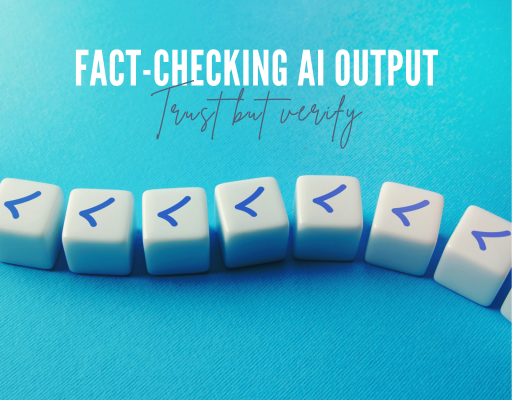As a business owner in the digital age, you are likely familiar with the power of Artificial Intelligence (AI). From virtual assistants to customer service chatbots, AI has revolutionized the way businesses operate, offering numerous opportunities to grow and streamline operations. However, as with any powerful technology, there are potential pitfalls to be aware of. I haven’t been this excited about technology in years, but these AI advancements also introduce new pitfalls to be aware of.

Remember the quote, “The best way to predict the future is to create it yourself”? In the context of AI, this means taking control of the technology and shaping it to fit your business needs, rather than blindly following trends or hoping for a miracle.
In this article, we’ll explore how to maximize the benefits of AI while avoiding common pitfalls. We’ll dive into several examples, including the importance of fact-checking AI output, treating AI like a team member, and finding the right fit for AI in your business processes.
Don’t Share Anything Confidential
Make sure you don’t share anything confidential about your business or your clients with AI tools. You should assume that your inputs will either be used to train the AI engine or could be searched by others in the future.
Think of an AI chatbot like the Google search engine. You wouldn’t run a search with super-confidential information in a Google search because you know Google indexes it. Nor should you load that type of information into a chatbot if you want to best protect it.
Fact-Checking AI Output: Trust but Verify
AI has made mind-blowing strides in just the past few months, but it’s crucial to remember that it’s not infallible. While AI algorithms can analyze vast amounts of data quickly and accurately, they can also produce misleading or inaccurate results. This is especially true when working with unstructured data, like natural language or images.

For example, if you’re using AI to analyze customer feedback, the algorithm might struggle to interpret sarcasm or idiomatic expressions, leading to misunderstandings. Similarly, image recognition software might misidentify objects or individuals in photos, leading to false conclusions. As yet another example, AI might give incorrect article citations or dead links.
To maximize the benefits of AI, always fact-check its output. This doesn’t mean you need to verify every single data point, but it’s important to establish a system for cross-referencing AI-generated insights with human knowledge. Establishing a “trust but verify” approach will help you harness the power of AI while avoiding costly errors.
Talk to AI Like a Team Member
AI systems learn and improve over time, especially when they receive feedback. Just like you’d give to a human team member, providing conversational instructions and initial instructions and feedback on a project, providing feedback to your AI tools helps them understand what direction to go and where they need improvement.
For instance, if you’re using an AI tool to help you write a blog article, was it able to understand your request for the direction to take the article? Did you give it enough direction like you would to a team member on what you wanted to see? Your input can help the AI system refine its understanding and ultimately provide better service.
Don’t Force AI to Fit Where It Doesn’t: Find the Right Applications
AI has incredible potential, but it’s not a magic wand that can solve every problem. Trying to force AI into situations where it’s not the best fit can lead to frustration and wasted resources. Instead, take a step back and assess your current processes to identify where AI can truly make a difference.

For example, if your business relies heavily on manual data entry, implementing AI-powered Optical Character Recognition (OCR) software can dramatically reduce errors and save time. Alternatively, if your sales team spends countless hours prospecting leads, an AI tool that predicts customer behavior and identifies high-potential leads could significantly boost productivity.
By carefully selecting the right AI applications, you’ll be able to automate and streamline your operations without introducing unnecessary complexity or frustration.
Additional Tips for Navigating AI Pitfalls
- Start Small: Rather than attempting a massive AI overhaul, begin with smaller projects that can deliver quick wins. This will help you build confidence in the technology and allow you to hone your AI implementation skills before tackling larger, more complex initiatives.
- Invest in Education and Training: Ensure that your team is well-versed in the AI tools you’re using. Providing training and educational resources not only empowers your employees but also reduces the likelihood of errors caused by misunderstandings or misuse of the technology.
- Choose the Right AI Vendor: Leverage reputable AI vendors who have a proven track record in your industry. A reliable vendor can provide valuable guidance and support throughout the AI implementation process, helping you avoid common pitfalls.
- Keep an Eye on Ethics: AI has the potential to revolutionize business processes, but it can also introduce ethical challenges, such as bias in algorithms or invasion of privacy. Stay informed about ethical concerns related to AI and make sure your company’s practices align with best practices and guidelines.
- Evaluate ROI: Regularly assess the return on investment (ROI) of your AI initiatives. This will help you identify which projects are generating value for your business and which ones may need to be adjusted or abandoned.
- Stay Informed: AI technology is evolving rapidly, and staying up-to-date on the latest developments can help you make more informed decisions about how to leverage AI in your business. Attend industry conferences, read research papers, and follow thought leaders to stay on the cutting edge of AI innovation.
AI technology has the potential to transform the way businesses operate, offering countless opportunities for growth and efficiency. However, navigating the AI landscape can be challenging, especially for business owners who are new to the technology. By following the tips and strategies outlined in this article, you can maximize the benefits of AI while sidestepping common pitfalls. Ultimately, the key to AI success lies in understanding its limitations, choosing the right applications, and continuously refining your approach as you learn and grow.








